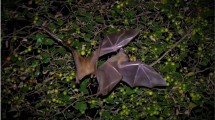Abstract
We report a sequence of behaviors exhibited by the short-nosed fruit bat Cynopterus sphinx while feeding on fruits of Mangifera indica. They peel off the outer skin to form a feeding area of about 3–6 cm diameter. Such food preparatory behaviors were more pronounced on larger mangoes. Bats competed among themselves to feed on the mangoes that had such feeding areas exposed. Individuals that spent a considerable amount of time on food preparatory behaviors actively secured the fruits. Altogether, these behaviors indicate that Cynopterus bats might have learnt, over evolutionary time, and developed behaviors that facilitate efficient processing and feeding of fruits such as mangoes. It appears that actions exhibited by C. sphinx in peeling off the outer skin of mangoes exemplify “extractive foraging”, a behavior that is prominently known in large-brained mammals. Thus, our findings will have implications on the distribution and evolution of extractive foraging and “technical intelligence” among mammalian lineages.






Similar content being viewed by others
References
Altmann J (1974) Observational study of behavior: sampling methods. Behavior 49:227–267
Arnold SJ (1983) Morphology, performance and fitness. Am Zool 23:347–361
Bates PJJ, Harrison DL (1997) Bats of the Indian subcontinent. Harrison Zoological Museum, England
Bhat HR (1994) Observations on the food and feeding behavior of Cynopterus sphinx Vahl. (Chiroptera, Pteropodidae) at Pune, India. Mammalia 58:363–370
Beck BB (1980) Animal tool behavior: the use and manufacture of tools by animals. Garland STPM Press, New York
Bonaccorso FJ, Gush TJ (1987) An experimental study of the feeding behavior and foraging strategies of phyllostomid fruit bats. J Anim Ecol 56:907–920
Byrne RW (1997) The technical intelligence hypothesis: an additional evolutionary stimulus to intelligence? In: Whiten A, Byrne RW (eds) Machiavellian intelligence: extensions and evaluations, vol II. Cambridge University Press, Cambridge, pp 289–311
Corlett C (1998) Frugivory and seed dispersal by vertebrates in the Oriental (Indomalayan) region. Biol Rev 73:413–448
Dumont ER (1999) The effect of food hardness on feeding behavior in frugivorous bats (Phyllostomidae): an experimental study. J Zool 248:219–229
Dumont ER (2003) Bats and fruit: An ecomorphological approach. In: Kunz TH, Fenton B (eds). Bat Ecology, University of Chicago Press, Chicago pp 398–429
Dumont ER, Herrel A (2003) The effects of gape angle and bite point on bite force in bats. J Exp Biol 206:2117–2113
Dumont ER, O’Neil R (2004). Food hardness and feeding behavior in old world fruit bats (Pteropodidae). J Mammal 85:110–116
Fleming TH (1982) Foraging strategies of plant-visiting bats. In: Kunz TH (ed) Ecology of bats, Plenum Press, New York, pp 287–325
Fleming TH (1993) Plant-visiting bats. Am Sci 81:460–467
Gibson KR (1986) Cognition, brain size, and the extraction of embedded food resources. In: Else JE, Lee PC (eds) Primate ontogeny, cognition, and social behavior, Cambridge University Press, Cambridge, pp 93–103
Heller JA (2000) Extractive foraging behavior and brain evolution in large-brained mammalian lineages, with special emphasis on primates and the genus Homo. Am J Phy Anthropol S30:175–176
Huber L, Gajdon GK (2006). Technical intelligence in animals: the kea model. Anim Cogn 9:295–305
Izhaki I, Korine C, Arad Z (1995) The effect of bat (Rousettus aegyptiacus) dispersal on seed germination in eastern Mediterranean habitats. Oecologia 101:335–342
Lehner PN (1996) Handbook of ethological methods, 2nd edn. Cambridge University Press, Cambridge
Lima SL, Dill LM (1990) Behavioral decisions made under the risk of predation: a review and prospectus. Can J Zool 68:619–640
Martin P, Bateson P (1986) Measuring behavior, an introductory guide. Cambridge University Press, Cambridge
McFarland D (1981) The oxford companion to animal behavior. Oxford University Press, New York
Norberg UM, Rayner JMV (1987) Ecological morphology and flight in bats: wing adaptations, flight performance, foraging strategy and echolocation. Phil Trans R Soc Lon B 316:335–427
Pyke GH, Pulliam HR, Charnov EL (1977) Optimal foraging: a selective review of theory and tests. Q Rev Biol 52:137–154
Roberts TW (1942) Behavior of organisms. Ecol Monogr 12:339–412
Schoener TW (1971) Theory of feeding strategies. Ann Rev Ecol Syst 2:369–404
Singaravelan N (2002) Foraging behavior of fruit bats in orchards. PhD thesis, Madurai Kamaraj University, Madurai, India
Strait SG (1997) Tooth use and the physical properties of food. Evol Anthropol 5:199–211
Strait SG, Overdorff DJ (1996) Physical properties of fruits eaten by Malagasy primates. Am J Phys Anthropol Suppl 22:224
Vandoros JD, Dumont ER (2004) Use of the wings in manipulative and suspensory behaviors during feeding by frugivorous bats. J Exp Zool 301A:361–366
Vincent JFV (1991) Texture of plants and fruits. In: Vincent JFV, Lillford PJ (eds) Feeding and the texture of food. Cambridge University Press, Cambridge, pp 19–34
Wheatley BP (1988) Cultural behavior and extractive foraging in Macaca fascicularis. Curr Anthropol 29:516–519
Yamashita N (1996) Seasonality and site specificity of mechanical dietary patterns in two Malagasy lemur families (Lemuridae and Indriidae). Int J Primatol 17:355–387
Acknowledgments
We are grateful to M.K. Chandrashekaran, Ido Izhaki, Permut Robin and two unknown reviewers for corrections and comments to improve the manuscript. We thank R. Dhanabalan, R. Alagarsamy, J. Venkatesh, J. Siva, K. Madhan, and K. Rajesh for their strenuous and tireless assistance in the field. We thank K. Janarthanan and K. Chandrasekaran––jamindhars of Sandhaiyur––for permitting us to use their mango orchards for this study. Ministry of Environment and Forests (MoEF), Government of India, supported this work through a research grant to G.M. Bat Conservation International (BCI, USA) provided a research grant through a scholarship to NS.
Author information
Authors and Affiliations
Corresponding author
About this article
Cite this article
Singaravelan, N., Marimuthu, G. In situ feeding tactics of short-nosed fruit bat (Cynopterus sphinx) on mango fruits: evidence of extractive foraging in a flying mammal. J Ethol 26, 1–7 (2008). https://doi.org/10.1007/s10164-007-0044-1
Received:
Accepted:
Published:
Issue Date:
DOI: https://doi.org/10.1007/s10164-007-0044-1




